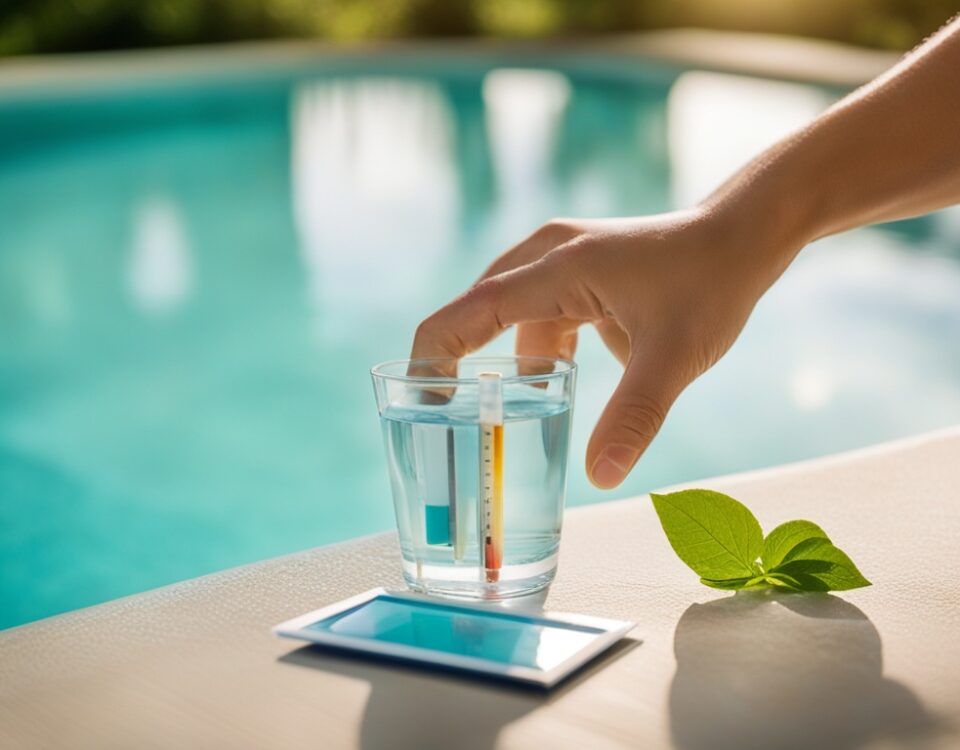Algae-Free Oasis: Effortlessly Remove Algae from Your Pool!

Illuminate Your Oasis: Brilliant Swimming Pool Lighting Ideas
May 2, 2025
Crystal Clear Secrets: Mastering the Art of Pool Filter Backwashing!
May 2, 2025Understanding Algae in Pools
Maintaining a clean pool is *not only vital for aesthetic appeal* but also essential for *health and safety*. Algae can thrive in a poorly maintained pool, leading to cloudy water, unpleasant odors, and potential health hazards. The presence of algae can deter swimmers from enjoying the pool, making *regular maintenance and vigilance* crucial for pool owners. Furthermore, algae can wreak havoc on swimming pool equipment, leading to costly repairs and inefficiencies.
Different Types of Algae Commonly Found in Pools
There are several types of algae that can infiltrate your swimming pool, each presenting its own unique challenges:
| Type of Algae | Characteristics | Common Locations |
|---|---|---|
| Green Algae | Most common; causes cloudy green water. | Walls, floors, and water surface. |
| black Algae | Dark blue-green and stubborn; often found on the pool surface. | Walls and cracks. |
| Yellow Algae | Also known as mustard algae; appears as yellow-brown patches. | Shaded areas of the pool. |
| Pink Algae | Not a true algae; appears as pink or reddish stains. | Tiles, ladders, and skimmers. |
Factors Contributing to Algae Growth in Pools
*Understanding the factors* that contribute to algae proliferation is essential for preventing significant outbreaks. Several environmental and operational aspects influence algae growth:
Lack of Proper Sanitization: Inadequate chlorine levels are a primary driver for algae growth. Chlorine is an essential pool sanitizer that eliminates bacteria and algae. Maintaining appropriate *free chlorine levels* is crucial; typically, this should be between 1 to 3 parts per million (ppm) for effective control.
pH Imbalance: Algae favor a *slightly alkaline* environment, making maintaining proper pH levels critical. An ideal pH level of 7.4 to 7.6 ensures that chlorine works effectively and discourages algae growth. Regularly testing and adjusting pH levels should be part of your pool maintenance routine.
Environmental Factors: Sunlight and organic debris can foster algae growth, especially when left unattended. Pools situated in sunny areas are particularly vulnerable to *green algae*, while shaded pools may battle *yellow algae*. Leaves, dirt, and other organic matter that accumulate in the pool not only inhibit circulation but can provide nutrients for algae.
Identifying Algae in Your Pool
Signs of Algae Presence in a Pool
Detecting the presence of *algae* in your swimming pool is crucial for maintaining a clean and safe environment. The most common signs include discoloration of water, which may manifest as a green, yellow, or black tint. Cloudy water is another significant indicator, suggesting an accumulation of organic matter that fosters algae growth. You may also observe slimy surfaces on pool walls or ladders, a result of algae adhering to these areas, creating a slippery surface. In some cases, a foul odor may emanate from the pool, signaling an imbalance in chemical levels and the presence of organic substances.
Steps to Confirm the Presence of Algae
To verify the existence of algae in your pool, follow these systematic steps:
- Visual Inspection: Begin with a thorough visual inspection of your pool. Examine the water color, looking for unusual tints, and inspect surfaces for any signs of green, yellow, or black residue.
- Water Testing: Conduct a water test using a pool water testing kit. Measure the levels of pH, alkalinity, and chlorine. Algae thrives in poorly balanced water, especially when chlorine levels are inadequate.
- Brush and Test: Using a pool brush, scrub the suspected areas. If the green color remains, it’s likely algae. Collect a small water sample from the affected area and examine it closely; *cloudiness* and color shifts will confirm algae presence.
Importance of Prompt Identification and Action
The *importance of promptly identifying* and taking action against algae cannot be overstated. Algae can multiply rapidly, turning a minor issue into a full-blown infestation that may require extensive measures to eradicate. If left unchecked, algae can lead to chlorine lock, which can further complicate pool maintenance and result in increased costs for treatments. Early detection also prevents the deterioration of pool equipment and surfaces, as algae can cause staining or corrosion over time.
Furthermore, the growth of algae presents health hazards to swimmers, as certain types can lead to skin irritations or respiratory issues. By addressing algae growth swiftly, you safeguard not only your pool’s aesthetic appeal but also the health and enjoyment of those who use it. A well-maintained and algae-free pool is a sanctuary, providing pleasure and relaxation for families and friends alike.
Manual Removal of Algae
Tools Needed for Manual Algae Removal
Successfully removing algae from your pool requires a few essential tools. Equip yourself with the following items to make the process efficient:
- Pool Skimmer: A long-handled skimmer is crucial for removing floating algae and debris from the water surface.
- Brush: A stiff-bristled pool brush is ideal for scrubbing algae off pool walls and floors. Opt for one with a telescoping pole for easier access to deep areas.
- Vacuum: A manual or automatic pool vacuum helps in sucking up settled algae and dirt. If using a manual vacuum, attach it to a pool pole.
- Water Test Kit: This kit helps in checking chemical levels, ensuring the water’s pH and chlorine levels are balanced to prevent future algae growth.
- Protective Gear: Rubber gloves and goggles will protect your skin and eyes from chemicals and debris during the cleaning process.
Step-by-Step Guide on Physically Removing Algae from the Pool
Embarking on an algae removal project takes time and patience. Follow these steps for a thorough manual cleaning:
- Skim the Surface: Start by using your pool skimmer to remove any floating algae or debris. This initial step prevents debris from settling at the bottom, making future steps easier.
- Brush the Walls and Floor: Using your stiff-bristled brush, scrub the stained areas vigorously. Focus on spots that appear slimy or green, as these are often breeding grounds for algae. Move in a consistent pattern to ensure every surface is addressed.
- Vacuum the Pool: Attach your vacuum to the pool hose and begin vacuuming from the deep end towards the shallow end. This allows for effective removal of settled algae. Always use the manual vacuum method if the algae problem is severe.
- Empty the Filter: After vacuuming, clean or backwash your pool filter to remove any trapped algae and prevent it from re-entering the pool water.
- Add Chemicals: Once physical removal is completed, use the water test kit to check pH levels and add appropriate chemicals, such as algaecide, to eliminate any remaining algae spores.
Tips for Preventing the Spread of Algae During Removal
To ensure effective algae removal and to mitigate the risk of spreading algae while you clean, consider these key tips:
- Work Methodically: Always start from one end of the pool and work towards the other. This prevents inadvertently stirring up algae, leading to further contamination.
- Clean Equipment Regularly: Before using your skimmer, brush, and vacuum, rinse them off with clean water to eliminate any existing algae that may transfer back into the pool.
- Avoid Pool Use: During the cleaning process, keep the pool closed to users. This minimizes the chances of spreading algae or disturbing the settled debris.
- Monitor Chemical Levels: After cleanup, consistently monitor and balance your pool’s chemicals to prevent future algae blooms. Maintaining proper pH and chlorine levels is critical.
Chemical Treatment for Algae
Types of Algaecides Available for Pool Treatment
To effectively combat the unsightly presence of algae in your swimming pool, various types of *algaecides* are available on the market. These chemical treatments can be broadly categorized into three primary types: quaternary ammonium compounds (quats), metal-based algaecides, and polymer-based algaecides. Quats are popular for their ability to kill algae upon contact and are effective against all types of algae, including green, yellow, and black varieties. Metal-based algaecides, often containing copper, are powerful and serve both as a preventative and a treatment option, albeit with precautions regarding water balance. Finally, polymer-based algaecides are particularly effective for preventing algae growth in the first place, acting as a barrier against future infestations.
Proper Dosage and Application of Algaecides
The *dosage* of algaecides is crucial for ensuring their efficacy while minimizing potential harm to swimmers and pool surfaces. Typically, the dosage guidelines are specified on the product label; however, a general rule of thumb is to maintain a ratio of 1-2 ounces of algaecide per 10,000 gallons of water during initial treatment. For ongoing maintenance, adjusting the dosage to 1 ounce for the same volume weekly can help prevent algae regrowth. The application process typically involves distributing the algaecide evenly across the pool surface, and for best results, it should be done when the sun is not at its peak intensity—preferably in the evening or at dusk. It is also advisable to run the pool filter for at least 24 hours after application to help ensure thorough circulation and absorption of the treatment.
Safety Precautions When Using Chemical Treatments
While the efficacy of chemical treatments is well acknowledged, *safety* should always be paramount. When handling algaecides, it is imperative to wear appropriate personal protective equipment, including gloves and goggles, to prevent skin irritation or eye damage. Additionally, ensure that the area is well-ventilated and avoid inhaling fumes directly. It is crucial to store algaecides in a cool, dry place away from children and pets, as well as to keep them away from incompatible substances. Furthermore, before introducing any chemical to your pool, testing the water for pH levels and total alkalinity is essential, as improper balance can lead to reduced efficacy of the algaecides and potential damage to your pool equipment.
| Type of Algaecide | Effectiveness | Notes |
|---|---|---|
| Quaternary Ammonium Compounds | Effective against various algae types | Best as a contact killer |
| Metal-Based Algaecides | Powerful, preventative, and treatment | Copper can stain if overused |
| Polymer-Based Algaecides | Prevents algae growth | Helps maintain water clarity |
Combining Algaecide Treatments with Other Pool Maintenance Practices
For optimal results, *combining algaecide treatments* with comprehensive pool maintenance practices is essential. Regular skimming, brushing, and vacuuming will help eliminate algae spores and debris before they can take root. Additionally, maintaining balanced water chemistry—specifically pH levels between 7.2 and 7.8, and total alkalinity between 80-120 ppm—will enhance the effectiveness of algaecides and contribute to overall water quality. Monitoring chlorine levels and ensuring adequate circulation from your pool pump can significantly reduce the likelihood of future algae blooms, creating a cleaner and more inviting swimming environment.
Preventing Algae Growth in Pools
Regular Maintenance Routines to Prevent Algae Formation
To keep your pool crystal-clear and algae-free, establishing a *regular maintenance routine* is indispensable. This begins with routine cleaning that involves skimming the surface for debris, brushing the walls and floor of the pool, and vacuuming as necessary. Aim to perform these tasks at least once a week to disrupt any potential algae growth before it takes hold. Additionally, test your pool water weekly using a reliable test kit to monitor key elements affecting water quality.
Importance of Proper Pool Circulation and Filtration
Proper circulation and filtration form the cornerstone of algae prevention. The pool pump should run for a minimum of 8 to 12 hours daily, ensuring that the water is effectively circulated and all areas of the pool receive proper treatment. This consistent movement helps to prevent stagnant zones where algae thrive. Investing in a high-quality filtration system, whether sand, cartridge, or diatomaceous earth, can significantly enhance water clarity and overall pool health.
Tips for Maintaining Balanced Water Chemistry
Maintaining *balanced water chemistry* is vital in deterring algae growth. The pH level should stay between 7.2 and 7.6, while the alkalinity should be maintained between 80 and 120 ppm (parts per million). Regularly add chlorine to keep levels between 1 and 3 ppm, as this is essential for killing any microscopic algae spores that may appear. Testing for calcium hardness and stabilizer levels is also necessary; calcium hardness should be between 200 and 400 ppm to prevent scaling and protect pool surfaces.
Utilize Algaecides Effectively
Occasionally, the use of *algaecides* can serve as an effective preventive measure against algae. Applying an algaecide according to the manufacturer’s instructions can provide an additional layer of protection, especially during the warmer months when algae are most likely to thrive. Choose a product that suits your pool type and the specific algae strain you may be battling.
Keep Your Pool Cover Clean
When your pool is not in use, a clean and *well-maintained pool cover* can work wonders in preventing algae growth. Ensure that debris does not accumulate on the cover and that it is properly secured. This will minimize the amount of sunlight reaching the water, as algae flourish in *sun-drenched environments*, and can hinder their growth potential significantly.
Regularly Inspect and Maintain Your Equipment
Lastly, *regular inspection and maintenance* of pool equipment, including skimmers, filters, and pumps, should never be overlooked. Ensure that these components are clean and functioning optimally to promote effective water circulation and filtration. Investing time in routine checks can save you substantial effort and cost in combating algae infestations later.
| Water Chemistry Parameters | Ideal Range |
|---|---|
| pH Level | 7.2 – 7.6 |
| Alkalinity | 80 – 120 ppm |
| Chlorine Level | 1 – 3 ppm |
| Calcium Hardness | 200 – 400 ppm |
Natural Remedies for Algae Removal
Using Natural Additives Like Baking Soda or Vinegar
For pool owners seeking *eco-friendly* solutions, natural additives such as baking soda and vinegar present a viable alternative to harsh chemical treatments. Baking soda is particularly effective due to its alkaline properties, which can help to balance the pH levels of pool water while simultaneously disrupting algae growth. To employ this remedy, simply add 1 pound of baking soda per 10,000 gallons of water. This will not only enhance water clarity but also make it inhospitable for algae.
Vinegar, on the other hand, is renowned for its acidity, which can effectively eliminate algae blooms when applied directly. A solution of 1 cup of white vinegar mixed with 1 gallon of water can be sprayed onto the affected areas. Allow it to sit for approximately 30 minutes before scrubbing, rinsing, and filtering the pool water to ensure maximum efficacy. *Always* perform a test on a small surface area to avoid any unintended damage.
Benefits of Eco-Friendly Algae Removal Methods
Adopting *natural remedies* for algae removal comes with a multitude of benefits. Primarily, these methods reduce the pollution associated with chemical treatments, thereby promoting a healthier swimming environment not only for humans but also for local wildlife. Additionally, using natural additives can lead to *long-term cost savings*, as it often decreases the need for frequent chemical balancing and maintenance. With eco-friendly solutions, pool owners can bask in the satisfaction of maintaining clean waters while contributing positively to the environment.
Precautions When Using Natural Remedies in Pool Maintenance
While natural remedies offer compelling advantages, certain precautions must be observed to *protect the integrity of your pool*. It is essential to monitor the pH and alkalinity levels after introducing substances like baking soda and vinegar. An imbalance can lead to etching of pool surfaces or reveal potential damage to pool equipment. To ensure safety, keep a reliable test kit handy and adjust the chemical levels as needed.
Furthermore, avoid mixing vinegar with any chlorinated products or other chemicals, as this might create harmful reactions. When treating algae, it is advisable to maintain good circulation and filtration in your pool, which is crucial for maximizing the effectiveness of any natural or chemical remedy employed.
| Natural Remedy | Application Method | Benefits |
|---|---|---|
| Baking Soda | Add 1 lb per 10,000 gallons | Balances pH, inhibits algae growth |
| Vinegar | Mix 1 cup with 1 gallon of water | Eliminates algae, eco-friendly |
In summary, using natural remedies like baking soda and vinegar can effectively streamline your pool maintenance while safeguarding the environment. However, by taking necessary precautions, such as monitoring chemical levels and avoiding mixtures that could lead to hazardous reactions, pool owners can reap the benefits of a vibrant, algae-free oasis.
Hiring Professional Help
When faced with a severe *algae infestation*, it often becomes necessary to seek professional assistance. If you notice that the water in your pool has turned an unsightly green or murky color, or there is a persistent slime adhering to the walls, it may indicate an advanced growth of algae. These conditions usually signify that traditional cleaning methods may not suffice and that expert intervention is warranted. Additionally, if you have attempted multiple treatments without success, it may be time to consider hiring a professional pool maintenance service.
Benefits of Hiring a Professional Pool Maintenance Service
Engaging a professional for your pool’s maintenance can yield numerous *benefits*. Firstly, experts possess specialized knowledge and equipment that enable them to identify and eliminate algae more effectively than a typical homeowner. They are equipped with superior vacuum systems, chemical treatments, and algaecides that can swiftly tackle infestations. Moreover, their experience in dealing with various types of algae—be it black, green, or mustard—ensures that they are well-versed in the most effective eradication methods.
Another significant advantage of professional services is their comprehensive approach to pool maintenance. In addition to removing algae, professionals will conduct a thorough analysis of your pool’s chemistry, ensuring the water is balanced and safe for swimming. This holistic treatment prevents future outbreaks and contributes to overall pool health, ultimately enhancing your swimming experience. Furthermore, utilizing a professional can save you time and effort, allowing you to enjoy your pool rather than labor over its upkeep.
Questions to Ask When Choosing a Pool Maintenance Professional
When seeking to hire a pool maintenance service, it is crucial to make an informed decision. Here are some key questions to consider:
| Question | Importance |
|---|---|
| What is your experience with algae removal? | This assesses their expertise in handling infestations. |
| Are you licensed and insured? | This protects you from liabilities in case of accidents. |
| What services are included in your treatment plan? | This ensures you understand the scope of their offerings. |
| How do you handle follow-up maintenance? | To gauge if they provide continued support post-treatment. |
| Can you provide references or reviews? | Previous customer experiences will give insight into their reliability. |
By asking these questions, you can assess the professionalism and capability of potential pool maintenance services. A conscientious choice will not only help restore your pool to its pristine condition but also ensure lasting results in preventing future algae growth.
Learn more about Swimming Pool

Javier Morales is passionate about pool design, maintenance, and outdoor living. With years of hands-on experience, he offers practical tips, creative ideas, and expert insights to help readers make the most of their pool spaces. At Piscina Planet, Javier shares everything from seasonal care guides to the latest trends in pool innovation.




